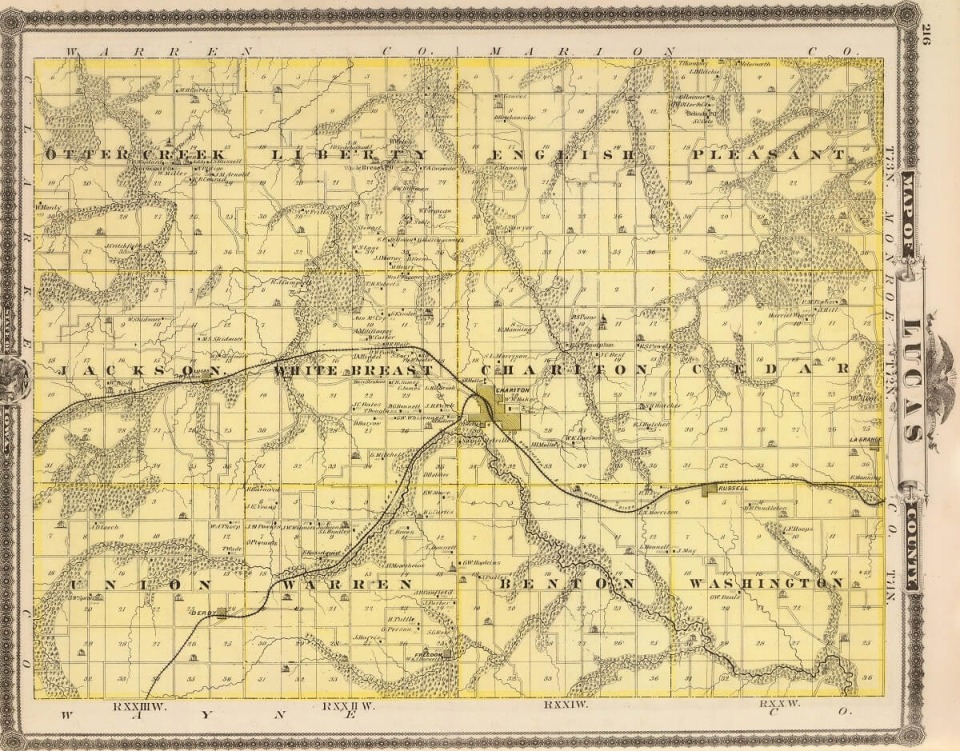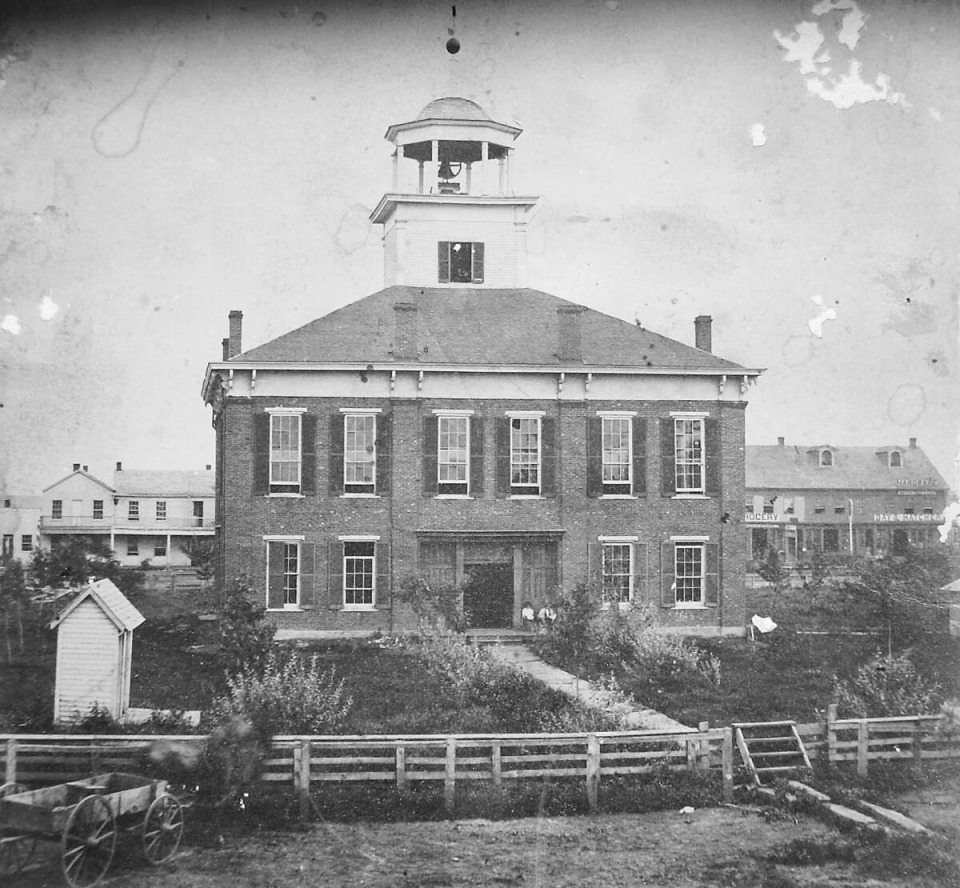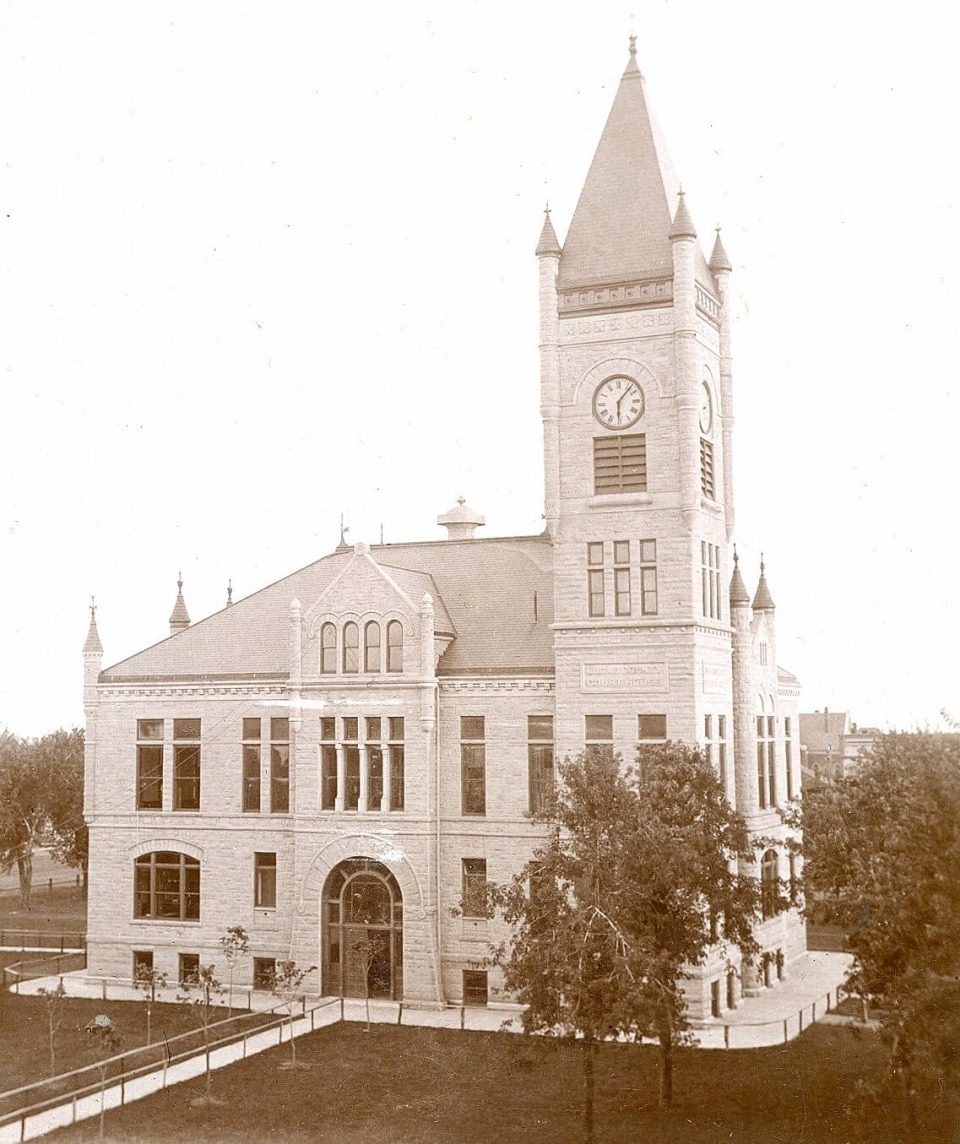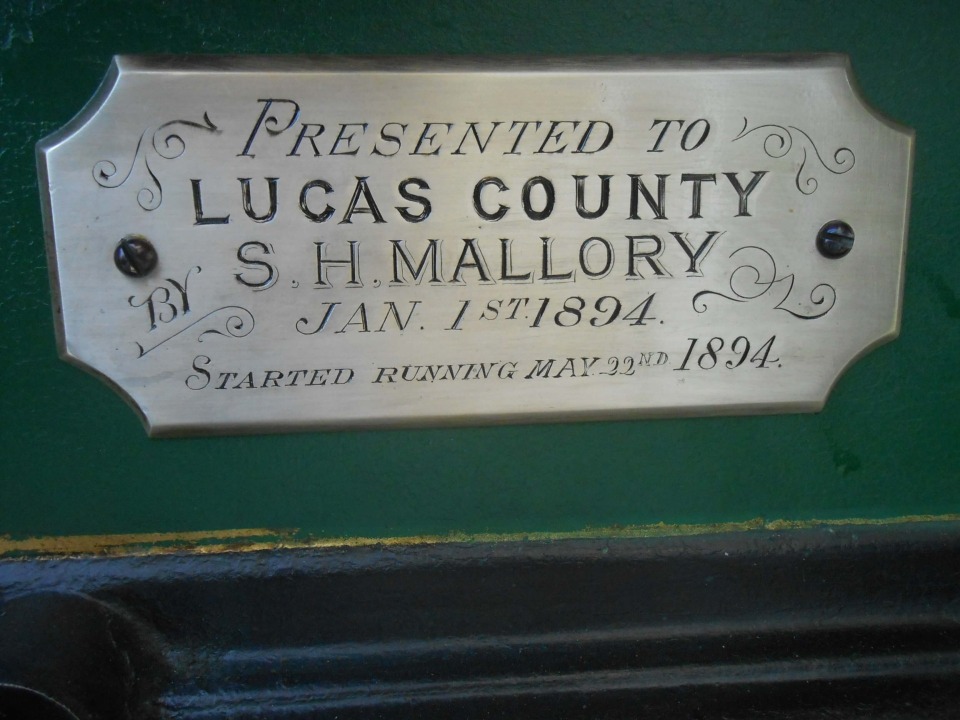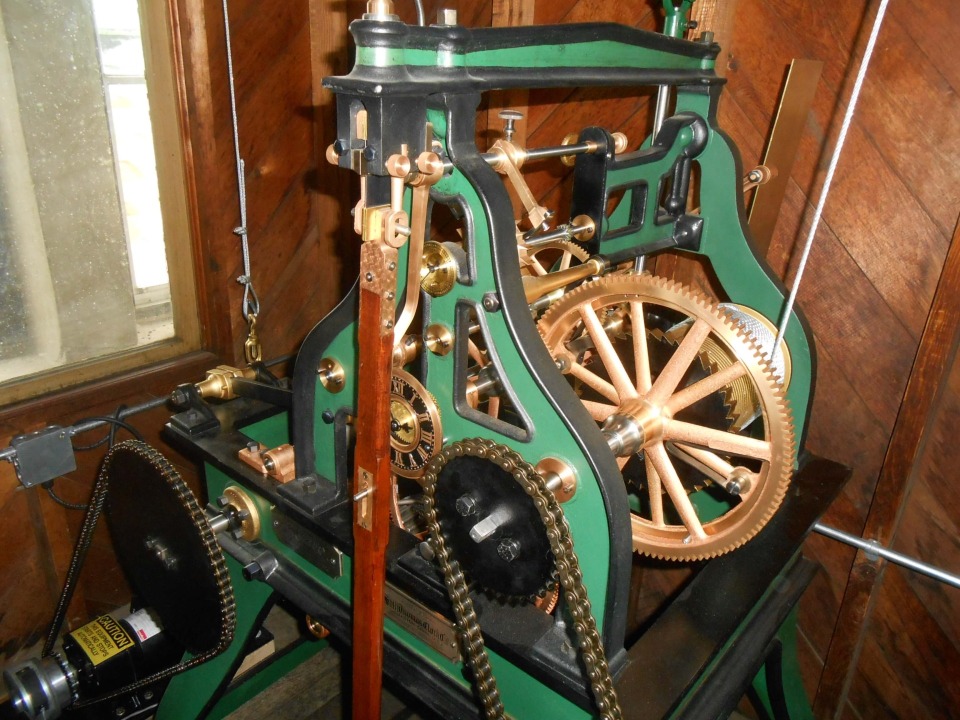About
Provided by Frank Myers of the Lucas County Historical Society
Created in 1846 and organized in 1849, it is named for Robert Lucas, Iowa’s first territorial governor. A mix of scenic wooded hills, river and creek valleys, and former prairie that now is productive farmland, the county’s economic base is agriculture, small industry, and large-scale distribution. Thousands of acres of public parks, state forests, and reserves make it a popular recreational destination.
Becoming Lucas County
Beginnings & Formation
Lucas County was, until the fall of 1842, recognized by the U.S. government as territory of the confederated Sauk and Fox (Meskwaki) nations and therefore closed to land claims by non-native settlers.
Although native Americans (most notably the Ioway for whom Iowa is named) had lived and hunted here for millennia, as their artifacts testify, they had touched the land lightly. It remained virgin prairie astraddle a high curved ridge dividing the Mississippi and Missouri river drainages punctuated by creek and river valleys fringed by timber and marsh.
The Chariton River, which flows south to join the Missouri River between Kansas City and St. Louis, and White Breast Creek, which flows north to join the Des Moines River north of Knoxville, are its two principal streams. The most widely known landmark during the earliest days was Chariton Point, just south of what now is the county seat city of Chariton, where the river of that name reached its most northerly point.
Under terms of a treaty signed at the Sauk and Fox agency east of what now is Ottumwa on Oct. 11, 1842, the Sauk, led by principal chief Keokuk, and the Fox, led by Poweshiek, ceded all of their claims to land west of the Mississippi to the United States in return for various financial considerations and the promise of new land in "Indian Territory" west of the Missouri River.
Under terms of that treaty, the Sauk and Fox agreed to move prior to May 1, 1843, west of a line drawn north to south from the Neutral Ground in northern Iowa to the Missouri border through the red rocks on the White Breast fork of the Des Moines River. That Red Rock Line formed roughly what now is the Lucas-Monroe county line.
The Sauk and Fox were given three years of grace to occupy the land west of the Red Rock Line, including Lucas County's territory, but pledged to leave Iowa by the third anniversary of the treaty, Oct. 11, 1845.
Lucas County was created three months after the Sauk and Fox title expired by an act of the final Iowa territorial Legislature dated Jan. 13, 1846, and named for Robert Lucas, the first territorial governor. That act defined county boundaries, directed that the uncharted territory be surveyed and placed it under the jurisdiction of Monroe County, which already was administering as best it could a county-wide strip of territory that stretched all the way to the Missouri River.
So far as anyone knows, there were no permanent settlers in Lucas County during that January, but history and geography soon would combine to turn the broadly curved ridge that bisects it into one of the nation's busiest highways.
First Settlers
During the spring of 1846, refugee members of the Church of Jesus Christ of Latter-day Saints, generally known as Mormons, began their flight west from Nauvoo, Illinois, across Iowa toward their eventual destination, the great Salt Lake Valley of Utah.
The first Saints, led by Brigham Young, crossed the iced-over Mississippi on Feb. 4, 1846. Upon arrival at Garden Grove in what now is Decatur County during late April, Young sent scouts back to direct those who followed to blaze a trail that followed the broad ridge that divides Lucas County. That trail crossed what now is the courthouse square in Chariton.
Thousands followed that trail, including the family party of Elder Freeman Nickerson, his wife, Huldah, and others who arrived at Chariton Point during November of 1846, but could go no farther as harsh winter weather descended. They spent the winter at Chariton Point and so were among the county’s earliest semi-permanent Euro-American residents. So far as is known, John and Hannah Ballard and their children, who had settled in English Township during August of 1846, were the only others living in the county at the time and they are considered to be the first permanent settlers.
Election & Chariton
A supplemental act ordering the organization of Lucas County and dated 14 January 1849 was passed by the second General Assembly of the state of Iowa. That act set July 4, 1849, as the date the county would gain its independence from Monroe and appointed James Roland, a resident of William McDermott’s "Ireland" neighborhood in Cedar Township, as organizing sheriff. His principal duty was to call an election on August 6, 1849, to select county officials and justices of the peace.
That election was duly held on Aug. 6 at the McDermott cabin with 25 men voting. Newly-elected county commissioners held their first meeting four days later, on Aug. 10, 1849, at the home of Buck Townsend, who by that time had purchased the Mormon claims and settled at Chariton Point. They were joined by three independent commissioners named by the Legislature to locate a county seat.
Those commissioners located and named the city of Chariton, just north of Chariton Point, an action affirmed by the new county commissioners on Aug. 11.
Once established and organized, the county began to fill with new settlers and Chariton became something of a boom town in 1853 when the federal land office serving south and southwest Iowa was moved here from Fairfield.
Arrival of the Railroad
Another boom era for the county came immediately after the Civil War when the first trains arrived in the county on tracks newly built by the Burlington & Missouri River Railroad (later Chicago, Burlington, and Quincy; now Burlington Northern & Santa Fe). Two of the county’s smaller towns, Russell to the east in 1867 and Lucas to the west in 1868, were developed along these tracks. Branch lines were constructed north to Indianola and south, eventually to St. Joseph, Missouri, during the 1870s, leading to the establishment of Derby in 1872 and the now-ghost village of Oakley. Completion of the north-south Rock Island Railroad line through the county in 1913 added Williamson to the list of county towns and turned Chariton for a time into a major rail hub served by two depots.
Coal & Mining
Although Lucas County always has been primarily agricultural, known for livestock production, coal was discovered under the county during the late 1870s and developed into a major industry that helped to shape the county for more than 60 years. Lucas County was among Iowa’s largest coal producers during many of those years and its mines, the largest and most technologically advanced. Labor leader John L. Lewis was born during 1880 into a Welsh mining family near Lucas. Coal continued to be a major factor in the economy until World War II. The last mine, Big Ben, closed during 1978.
Hy-Vee
The Hy-Vee supermarket chain has been a major player in Lucas County’s economy since 1945 when the corporation’s headquarters were relocated to Chariton from Lamoni. Although corporate headquarters were moved to West Des Moines in 1995, Hy-Vee reached maturity in Lucas County and the Chariton Distribution Center remains the county’s largest employer.
Present Day
Today, thousands of acres of public land offer limitless opportunities for outdoor recreation in Lucas County --- including Red Haw State Park, Stephens State Forest, the 13-mile Cinder Path recreational trail, Chariton River Greenbelt, Pin Oak Marsh and nature center, and other smaller parks and natural areas.
Lucas County Courthouses
Lucas County has been served by three courthouses since it was created during 1846.
The first was a story-and-a-half building of hewn logs built during 1850 on the west side of the Chariton square. This was the only public building in Lucas County at the time and served as home base for county officials, jail when needed, the site of court proceedings, and a location for public gatherings that ranged from church services to dances.
The second courthouse, a four-square brick structure in a style the blended late Greek revival with Italianate, was completed during 1858 on the site of the current courthouse. Four office rooms were located on the first floor, two offices, and a courtroom on the second. This building, too, served as Lucas County’s primary public gathering place until after the Civil War. In addition, county supervisors rented some of the offices out to lawyers, newspaper editors, and others to raise additional revenue.
Unfortunately, the 1858 courthouse had faulty foundations and it began to deteriorate almost immediately. By 1891, the building had become too dangerous to occupy, county offices were evacuated, court proceedings moved elsewhere and the building was demolished.
Construction of the current courthouse began during the late fall of 1892 and was completed during the early spring of 1894. The dedication occurred on May 22 of that year. The structure, with a 140-foot clock tower, is built of Berea sandstone and was designed in the Richardson Romanesque style by the Des Moines-based architectural firm of Foster & Liebbe.
Only one major change has been made during the building’s history --- in 1954, county supervisors decided that the spire of the courthouse tower was unsafe and rather than repairing it, ordered its removal.
Conserving this fine old building is a continuing process. The clock in the courthouse tower was donated by a local entrepreneur, Smith H. Mallory, and began running on the day of dedication. During 2016, it was restored and reinstated to mark Lucas County’s hours.

